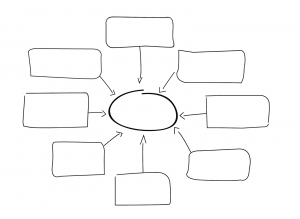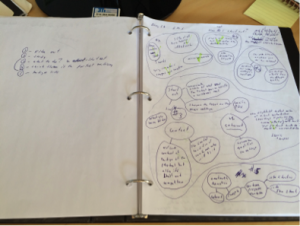Isn’t it incredible that the Internet has billions of pieces of interesting information floating around in it, yet you can still get writer’s block? Here’s a way to overcome it, based on a simple technique that you may not know about.
Title comes last
First off though, if you’re having trouble getting started on your piece, don’t worry about the title. In fact, it’s the last thing you have to worry about. Give yourself about 30 seconds to figure out a working title and move on to the subject matter. Same goes for the conclusion. Once you have completed your work on main subject, then go back and find a catchy title that summarizes what you have to say as well as a conclusion that is succinct and easy to remember.
Don’t expect to work in a linear fashion
A final text is well structured, linear and leads the reader to specific conclusions. The experience of building it however, isn’t linear at all. It can even seem really fragmentary. In the information hunting-gathering process of writing, you find bits and pieces scattered all over the place and in no particular order. As you surf through content, you’ll find additional ideas that can latch onto the ones you already have. Similar content kind of gravitates together in your mind. Your brain, looking at all this and getting alarmed at not seeing structure, will urge you start trying to put things in some sort of order. That’s the hard part.
Mind-mapping
There is a cool visual technique that can help you through this process called “mindmaping”. Basically, it consists of taking a blank piece of paper, and writing your ideas in bubbles.
Don’t laugh. I’m not finished yet.
Summarize each idea in one or two words to keep it simple. Your main idea goes in the middle of the page and secondary ideas float around it. Sub ideas of the main or secondary ideas can be smaller bubbles attached to their parent bubble. You’ll get a non-linear graphic representation of all your ideas that looks like this.
I’ve found that it is good technique to resort to when you having trouble with a particular subject. Its strength lies in how you can visualize all the ideas you’ve gathered so far and be able to free-associate them between each other. This can help you come up with unexpected associations.
This is the way I usually use mind-mapping. I start with two blank pages. On the right page I map out the ideas. Then, only after having anxiously stared at the bubbles for a while, I start writing out the sequence of ideas, as they will appear in my text, on the left page.
Normally after doing the work on these two pages, I then start writing in Word. Here below in a different example, I started writing full text on the left right away. No idea why. Doesn’t matter. I transcribed most of it into Word afterwards.
Notice that in both examples I wrote a lot of text inside some of the bubbles. It is not exactly how you are supposed to use the technique but that’s the way it works for me. Mind-mapping engages your creativity so I figure this is ok. Each person will have a slightly different way of doing it. Try using the technique as a starting point, and adapt it to how you work.
In the end, it should help you amass your content, organize it in sequential order and from there, the writing becomes much, much easier.
Content creation and content marketing are two of Exo B2B’s specialties. Let us know if you’d like to know more about our services.







